There are 15 types of snakes in Oregon including Garter snakes, Kingsnakes, Ringnecks, and one venomous species. Whether you need a herping guide for your next trip through the assorted geography of Oregon or you’re looking for a new pet, this list will absolutely prove of aid when it comes to knowing the ins and outs of the different snake species that inhabit Oregon.
Table of Contents
Snakes in Oregon
1. California mountain kingsnake
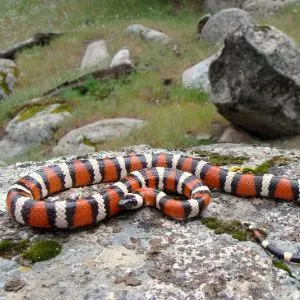
- Experience level: Beginner
- Family: Colubridae
- Scientific Name: Lampropeltis zonata
- Other Names: Milk Snake
- Adult Size: 20-30 inches (50.8-76.2 centimeters)
- Lifespan: Up to 20 years
- Average Price Range: $100-$200
California mountain kingsnakes are not only gorgeous in color, but they are considered one of the best pet snakes you can have as a pet. As a former kingsnake owner, I can definitely vouch for that.
These nonvenomous snakes can be easily recognized through their circular pattern of red, black, and creamy yellow bands and are typically found in the Rogue and Umpqua River valleys, as well as the Klamath Basin.
When out in the field, make sure not to mistake California mountain kingsnakes with the venomous coral snakes that reside in the southeastern portion of the United States (Quick tip: the yellow and red bands of coral snakes touch, while the yellow and red bands of kingsnakes will always be separated by black).
California mountain kingsnakes feed on other snakes, lizards, birds and their eggs, and small mammals such as rodents.
2. Common garter snake
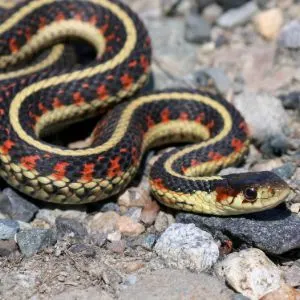
- Experience Level: Beginner
- Family: Colubridae
- Scientific Name: Thamnophis sirtalis
- Other Names: N/A
- Adult Size: 18-36 inches (45.72-91.44 centimeters)
- Lifespan: 8-10 years
- Average Price Range: $20-$300
The most abundant snake in the entire state of Oregon, the common garter snake can be found anywhere from the low, forested mountains of the coast to sagebrush deserts. They’re literally everywhere. Portland residents come across common garter snakes in their own backyards all of the time.
While the coloration of the common garter snake varies (green, blue, black, yellow, gold, red, brown, orange), the most defining and consistent feature is the dorsal stripe that runs down the length of its body. Common garter snakes eat earthworms, frogs, toads, salamanders, birds, fish, and small mammals.
3. Common kingsnake

- Experience Level: Beginner
- Family: Colubridae
- Scientific Name: Lampropeltis getula
- Other Names: Milk snake
- Adult Size: 24-48 inches (60.96-121.92 centimeters)
- Lifespan: Up to 20 years
- Average Price Range: $100-$250
In comparison to the California mountain kingsnake, the common kingsnake has a circular pattern of black and creamy white bands and is also found in the Umpqua and Rogue River valleys.
One intriguing fact about this species is they enjoy feeding on rattlesnakes as they’re immune to the venom. Outside of rattlesnakes, their diet consists of turtles, birds and their eggs, frogs, lizards, and a variety of small mammals.
4. Gopher snake

- Experience Level: Moderate
- Family: Colubridae
- Scientific Name: Pituophis catenifer
- Other Names: Bull snake
- Adult Size: 36-72 inches (91.44-182.88 centimeters)
- Lifespan: 12-15 years
- Average Price Range: $30-$110
Don’t misconstrue a gopher snake for a rattlesnake. That’s exactly what they want you to think! These ground-dwelling constrictors have the art of being incognito down to a tee, meaning they flatten their head, coil, strike, and hiss loudly in order to look like a rattlesnake when they feel threatened.
They also share the same coloration of a rattlesnake (yellow, straw, cream). The easiest way to spot the difference between a gopher snake and a rattlesnake is the tail. Gopher snakes do not have rattles. Rather, they have fine-pointed tails.
The gopher snake can be found everywhere in the state of Oregon, exempting both the coastal region and anywhere with an elevation above 6,000 feet. Their diet is contingent on size, with young snakes eating insects, lizards, and other small reptiles and adults eating larger prey such as rabbits.
5. Night snake
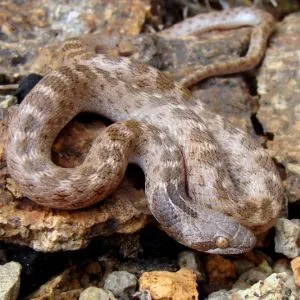
- Experience Level: Beginner to Intermediate
- Family: Colubridae
- Scientific Name: Hypsiglena torquata
- Other Names: N/A
- Adult Size: 12-26 inches (30-66 centimeters)
- Lifespan: >20 years
- Average Price Range: $150-$200
Hence its name, the night snake is rarely seen as it moves and hunts throughout the rocky areas of eastern Oregon only at night. Another reason they’re considered sneaky is their small size. If you think you may have run across one of these snakes, look to see if it has a grayish beige body with dark gray or brown blotches down its back and sides.
You should also take a look at its head. If it has a blotch on the back of its head and has copper-colored, cat-like pupils, you probably have found one of these creatures of the night.
The night snake, along with the western rattlesnake, is the only snake in Oregon that doesn’t have round pupils. They feed solely on cold-blooded prey, especially lizards, frogs, and toads.
6. Northwestern garter snake

- Experience Level: Beginner
- Family: Colubridae
- Scientific Name: Thamnophis ordinoides
- Other Names: N/A
- Adult Size: 24 inches (60.96 centimeters)
- Lifespan: Up to 20 years
- Average Price Range: $20-$30
Similar to the common garter snake, the northwestern garter snake can be found in a variety of places, from areas with dense vegetation to talus slopes to city parks. This species is not only smaller and more slender than other garter snakes, but it is often considered the most variably colored snake in all of Oregon. Northwestern garter snakes eat slugs and earthworms with the occasional small reptile or mammal.
7. Pacific coast aquatic garter snake

- Experience Level: Beginner
- Family: Colubridae
- Scientific Name: Thamnophis atratus
- Other Names: N/A
- Adult Size: 18-33 inches (45.72-83.82 centimeters)
- Lifespan: Up to 20 years
- Average Price Range: $20-$300
Pacific coast aquatic garter snakes always stay close to the water. Therefore, they can be found along rivers, marshes, and other moist areas. They actually, in theory, cannot live without water as diving beneath the surface is this species’ main form of escape.
Pacific coast aquatic garter snakes usually are olive-brown and sometimes feature light yellow dorsal stripes. Their diet consists of small fish and their eggs, salamanders, tadpoles, frogs, toads, earthworms, and leeches.
8. Racer

- Experience Level: Expert
- Family: Colubridae
- Scientific Name: Coluber constrictor
- Other Names: N/A
- Adult Size: 24-48 inches (60.96-121.92 centimeters)
- Lifespan: 15-20 years
- Average Price Range: $40-$80
Outside of the northern portion of the coast and the crest of the Cascades, the racer can be found statewide. It prefers warm and open countryside and avoids dense forests and high mountains. Comically enough, these brown, yellow-bellied snakes can often be seen crossing roads.
They’re very speedy animals, which is how they got their name. They’re also considered one of the worst snakes to keep as a pet. The racer’s diet consists of small mammals, other reptiles, and insects.
9. Ring-necked snake
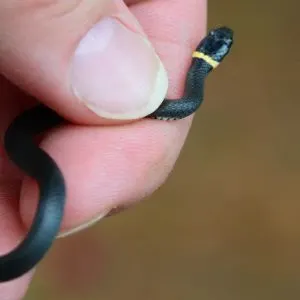
- Experience Level: Intermediate to Expert
- Family: Colubridae
- Scientific Name: Diadophis punctatus
- Other Names: Corkscrew, Thimble
- Adult Size: 10-16 inches (25.4-40.64 centimeters)
- Lifespan: 10-20 years
- Average Price Range: $40-$80
The ring-necked snake lives in the drier parts of southwest Oregon, the Willamette Valley, and the lower Deschutes River Valley. Nevertheless, it requires moist micro-habitats such as downed logs or stumps. These two-toned (grayish green on top and reddish orange below) can also be found along the Grande Ronde River and in Hells Canyon.
One easy way to point out a ring-necked snake is the reddish orange ring around its neck. This species eats salamanders, frogs, lizards, as well as other small snakes.
10. Rubber boa
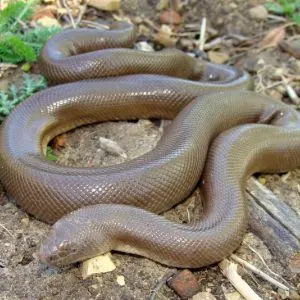
- Experience Level: Beginner to Intermediate
- Family: Boidae
- Scientific Name: Charina bottae
- Other Names: Montane constrictor
- Adult Size: 14-30 inches (35.56-76.2 centimeters)
- Lifespan: 20+ years
- Average Price Range: $150-$300
The rubber boa, simply through namesake, may sound like a massive snake as it is related to both the boa constrictor and the anaconda, but that’s not the case. Rubber boas can only grow up to two and a half feet, unlike their seven feet relatives.
Their name comes from the look of their skin which is loose, wrinkled, and dark brown—ultimately giving off the appearance of rubber. Rubber boas can be found throughout most of the state, except for the coast north of Coos Bay. They’re also very good climbers. A rubber boa’s diet mainly consists of small rodents.
11. Sharp-tailed snake

- Experience Level: Intermediate
- Family: Colubridae
- Scientific Name: Contia Tenuis
- Other Names: Oregon worm snake, Pacific ground snake
- Adult Size: 8-12 inches (20.32-30.48 centimeters)
- Lifespan: Up to 10 years
- Average Price Range: $110
Sharp-tailed snakes are typically found in woodlands and forests in southwest Oregon. This species lives a mostly subterranean life, which means it spends most of its time under logs and rocks. Thus, their diet revolves around slugs. Sharp-tailed snakes have smooth, gray or reddish-brown scales above and bars of black and cream underneath.
12. Striped whipsnake
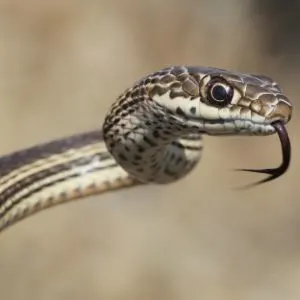
- Experience Level: N/A
- Family: Colubridae
- Scientific Name: Masticophis taeniatus
- Other Names: N/A
- Adult Size: 36-72 inches (91.44-182.88 centimeters)
- Lifespan: 10-20 years
- Average Price Range: N/A
The striped whipsnake inhabits most of Oregon. They prefer grasslands, sagebrush flats, stream courses, and canyon bottoms and can live in altitudes of up to 7,000 feet. Having a somewhat similar appearance to its close relative in the racer, striped whipsnakes are dark in color with light side stripes.
Both the striped whipsnake and the racer also hunt with their heads above the ground. Striped whipsnakes mainly feed on lizards, other snakes, and small mammals.
13. Western ground snake
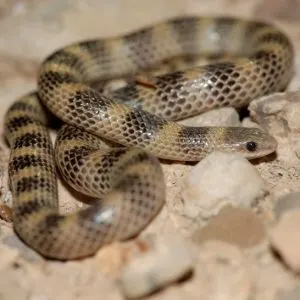
- Experience Level: N/A
- Family: Colubridae
- Scientific Name: Sonora semiannulata
- Other Names: The common ground snake
- Adult Size: 8-19 inches (20.32-48.26 centimeters)
- Lifespan: Not observed
- Average Price Range: N/A
Western ground snakes vary in coloration as individuals can be brown, red, or bright orange with black banding, brown or orange striping, or solid-colored. They are found in sandy areas, usually in desert scrub vegetation or underneath objects at the edge of a wash. Different from most of the snakes on this list, the western ground snake mainly feeds on small arthropods such as spiders, scorpions, centipedes, crickets, and grasshoppers.
14. Western rattlesnake

- Experience Level: Expert
- Family: Viperidae
- Scientific Name: Crotalus viridus
- Other Names: N/A
- Adult Size: 18-36 inches (45.72-91.44 centimeters)
- Lifespan: 15-20 years
- Average Price Range: $125
Oregon’s only indigenous snake, the western rattlesnake, can be distinguished through its broad, triangular head and small neck (just like you learned in elementary school—venomous heads have distinct heads while non-venomous snakes have rounded heads), as well as the rattles on the end of its tail.
The western rattlesnake has two sub-species that are recognized in Oregon, the Northern Pacific rattlesnake and the Great Basin rattlesnake. Western rattlesnakes can typically be found near rocks or cliffs as they’re a sucker for dens and crevices. Their diet mostly consists of small mammals.
15. Western terrestrial garter snake
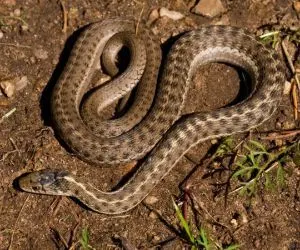
- Experience Level: Beginner
- Family: Colubridae
- Scientific Name: Thamnophis elegans vagrans
- Other Names: N/A
- Adult Size: 18-33 inches (45.72-83.82 centimeters)
- Lifespan: Up to 20 years
- Average Price Range: $20-$300
The western terrestrial garter snake, which has four subspecies that all prefer different habitats, can be found everywhere in Oregon, exempting the central and north coastal areas and much of the eastern slope and crest of the Cascades. They’re typically grayish brown or black with a dark checkered pattern between yellow stripes.
In opposition of its name, some subspecies of the western terrestrial garter snake actually spend a lot of time in the water. Just like habitats, their diet varies among subspecies with the aquatic subspecies feeding on fish, frogs, and leeches and the more terrestrial forms feeding on frogs, toads, lizards, small mammals, salamanders, and slugs.
Frequently Asked Questions about Snakes in Oregon
Can you own a snake in Oregon?
According to the Oregon Department of Fish and Wildlife, it is legal to own a nonvenomous snake in Oregon. My personal recommendation for beginners would be to start out with either a kingsnake or a garter snake.
What poisonous snakes live in Oregon?
As touched on earlier in this list, the only snake in Oregon poisonous to humans is the western rattlesnake.
How many rattlesnake bites are there per year in Oregon?
In Oregon, the number is at a low 35-55 snakebite calls per year as (1) rattlesnakes just aren’t all that common in Oregon, and (2) 32 percent of those bites come from intentional handling as rattlesnakes don’t see humans as prey and typically will not bite unless threatened.
When it comes to the Western rattlesnake, the smartest thing you can do is let it be—unless you’re an expert. It’s not like you can legally have one as a pet anyways. In case of a rattlesnake bite, see the Oregon Health and Science University website.
Conclusion
That’s a wrap! Thanks for reading, and we hope this list of the 15 snakes that live in the state of Oregon was beneficial—whether you’re looking to herp or for a new pet. Feel free to comment below and discuss Oregon’s snakes with fellow enthusiasts.
Snakes in other states
